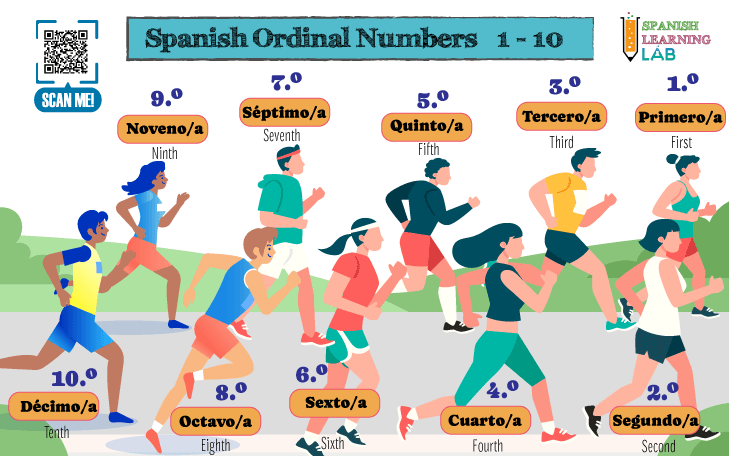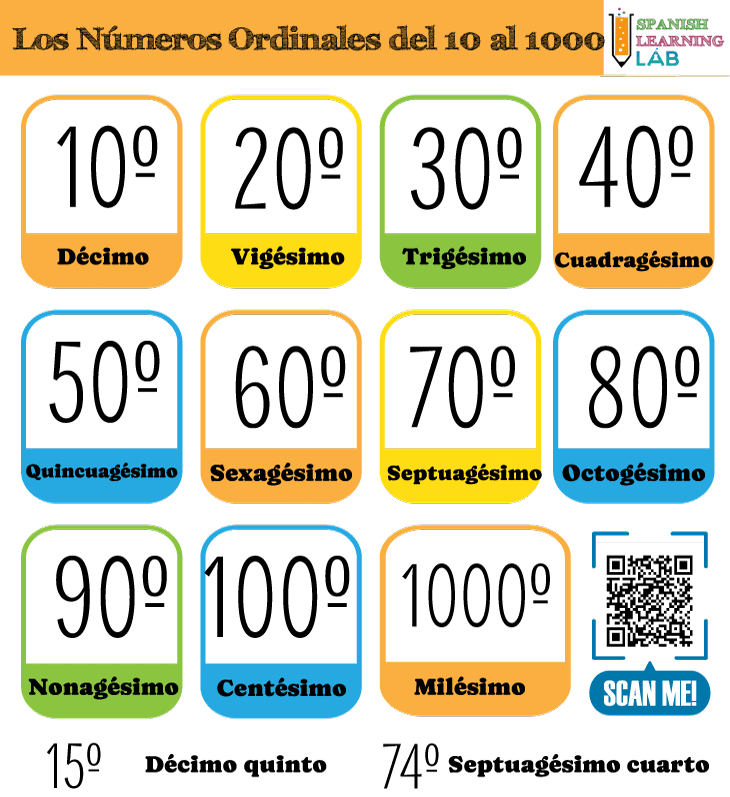Spanish ordinal numbers, “los números ordinales”, are used to show the order that things or events follow, whereas cardinal numbers are used to talk about quantities. Both of them are very useful in many situations in the language. In this lesson, we will learn how to use and write Spanish ordinal numbers in sentences where they would normally appear. You will listen to many examples and solve some exercises on ordinal numbers with an interactive quiz. Comencemos…
Introductory video: Ordinal Numbers in Spanish 1-10
LOS NÚMEROS ORDINALES or Spanish ordinal numbers correspond to words like first, second, third and so on in English. They are used almost in the same way in both languages, although we do not use ordinals as much as we use cardinals. In fact, most people don’t even know how to say ordinal numbers after the 10th number. We created a video for ordinal numbers in Spanish 1-10 including a few examples of sentences using them. Make sure to watch the video completely and read the notes we put in some of the slides.
How to say and write ordinal numbers in Spanish 1 – 10
Ordinals are used to talk about things like positions and grades. The picture below shows how to write ordinal numbers in Spanish 1 – 10. The word “DÉCIMO + an ordinal number 1 – 9” will be used to create numbers from 11 to 19, which is why remembering ordinals from 1 to 10 is so important.
The numbers PRIMERO and TERCERO will be written as PRIMER and TERCER when they are placed before a masculine noun like “regalo”, for example: “Mi primer regalo” (my first gift) and “Su tercer hijo”. Otherwise, you should write them as PRIMERO and TERCERO like in the sentence “Soy el primero” (I am the first one) or for steps as in “Primero, abre la caja” (First, open the box). There is a rule that says you must use PRIMERA and TERCERA before a feminine noun. However, in the video we included an example that says “Soy la primer taza” (I am the first cup). That is the way that many native speakers would say it, although the grammatically correct version is: “Soy la primera taza” (using PRIMERA instead of PRIMER).

All Spanish ordinal numbers have either a masculine or feminine gender, except for PRIMER and TERCER. The ordinal number QUINTO, for example, will change to QUINTA in the sentence “Ella es la quinta” (She is the fifth one) because we are talking about a girl, but it does not change in “Estoy en quinto grado” (I am in 5th grade) because GRADO is masculine noun. This means that numbers like other adjectives must agree with the noun they modify.
Making sentences using Spanish ordinal numbers
Sentences with ordinal numbers in Spanish will normally use numbers from 1 to 10 because they are the most common in the language. Since it would be very difficult even for a native speaker to say something like “I am the 30th”(Soy el trigésimo), we often use the phrase “EL NÚMERO + a cardinal number” instead. With that said, the sentence “Soy el trigésimo” could be easily rephrased as “Soy el número treinta”. This last sentence is way more natural than the first one and would actually make more sense in real conversations. You could also use this rule for numbers from 1 to 10 if you want as well, e.g. “Soy el número uno”.
Spanish ordinal numbers are placed before nouns: “La primera casa”, “El noveno libro” and so on. They can also play the role of the subject of sentences with the help of definite articles (EL/LA/LOS/LAS) as in “El primero es el ganador” (the first one is the winner). In addition, there is more that one way to say a few of them, like in the case of the number “12th” that could be said as “duodécimo”, “decimosegundo”, or “décimo segundo”. The form “decimosegundo” was accepted in 2005 by the Royal Spanish Academy.

Examples of sentences using ordinal numbers in Spanish
Here are some audio examples using Spanish ordinal numbers in sentences with the grammatical structures we have explained. Press PLAY to listen to the examples.
|
Yo soy la primera persona
I am the 1st person
|
|
Ella está en segundo grado
She is attending 2nd grade
|
|
Nuestro equipo ganó el tercer lugar
Our team won the third place
|
|
Él es el cuarto
He is the 4th one
|
|
¿Él está en quinto grado?
Is he in 5th grade?
|
|
El sexto sentido
The sixth sense
|
|
Este es el séptimo intento
This is the 7th attempt
|
|
La octava canción en el álbum es buena.
The eighth song of the album is good
|
|
El noveno grado no es tan difícil.
Ninth grade is not that difficult
|
|
Este es nuestro décimo aniversario de bodas
This is our 10th wedding anniversary
|
|
Fue inventado en el siglo once (décimo primer siglo)
It was invented in the 11th century
|
|
Este es nuestro pájaro número doce (el décimo segundo pájaro)
It is our 12th bird
|
|
Esta es tu foto número trece (décimo tercer foto)
It is your 13th picture
|
|
Estamos en el siglo veintiuno (el vigésimo primer siglo)
We are in the 21st century
|
|
Este es mi cumpleaños número veinticinco (vigésimo quinto)
This is my 25th birthday
|
|
Esta es la vez número cien que practicamos (la centésima vez)
This is the 100th time we practice
|
